PURPOSE This study identified a company sports club’s dual characteristics— both for leisure activity and as an extension of work—to provide comprehensive interpretation and understanding of such clubs. METHODS A qualitative case study design was employed, incorporating in-depth interviews, nonparticipant observation, and supplementary data collection from 25 office workers who had participated in an in-house sports club for at least one year. RESULTS Participants reported a wide spectrum of motivations, from voluntary motives such as stress relief and health improvement to more obligatory or organizationally driven motives, including pressure from supervisors or colleagues and expectations related to performance evaluations. The club offered both team sports—which fostered teamwork and a sense of belonging—and individual sports—which offered personal development opportunities. However, some participants experienced blurring of work–leisure boundaries and reemergence of hierarchical organizational culture, leading to conflict and fatigue. CONCLUSIONS Overall, Although company sports clubs have become a welfare program that provides employees with opportunities for leisure and self-development and promote inter-departmental communication and collaboration, they also carry the latent risk of imposing additional burdens and pressures on employees. These findings underscore the need for refined operational strategies and institutional improvements to mitigate negative outcomes and maximize such programs’ original intent.
PURPOSE This study aims to analyze research trends on the social capital in sports. METHODS A total of 69 papers published until December 2020 were selected as research subjects. Further, Excel, KrKwic software, and NetDraw function of the UCINET 6 program were used for analysis. RESULTS First, social capital research on sports has shown quantitative growth since 2010. Second, the studies were conducted on sports participants such as general, elderly, college students, adolescents, foreigners, and the disabled, showing the highest frequency of research subjects. Third, quantitative research conducted based on the research method were several. Fourth, single-author studies were the highest. Fifth, as the result of the analysis on the publication journal, the Journal of the Korean Physical Education Association was shown the highest. Sixth, due to frequency analysis of the thesis keywords, “social capital,” “sports participation,” “action intention,” “social capital type,” “living sports participation,” and “youth” were shown the highest. Seventh, as a result of centrality analysis between keywords through the network analysis, “sports participation” in connection centrality, “health-promoting lifestyle” in proximity centrality, and “sports participation” in mediation centrality were found as the highest. CONCLUSIONS The significance of social capital in sports is more important than others because it is a fundamental element for creating a culture where more people can enjoy sports moderately in Korea, where capitalism and liberal democracy were adopted as the governing system. Therefore, this study can be a vital resource significantly contributing to the understanding and active use of social capital, a significant factor in developing sports in Korea.

Purpose Soccer-related social media BigData includes complex information related to soccer players and is continuously and instantly generated. Text mining research is actively carried out for this kind of social media contents analysis, but it tends to be analyzed with limited linguistic characteristics such as understanding of language complexity and context, ambiguous terms, rhetoric, and new terms. This can be attributed to the fact that the tools commonly used for text mining use universal terminology dictionaries and packages that exclude the peculiarities of the analysis themes. The purpose of this study is to develop an Ontology model, which are representative tools for defining semantic ambiguity and relationships and systems between terms of text data. Methods In order to achieve the research objectives, we applied the 7-step development method of ‘Ontology Development 101: A Guide to Creating Your First Ontology’, which is useful for ontology development. Each step includes 1) Determine the domain and scope of the ontology 2) Consider reusing existing ontology 3) Enumerate important terms in the ontology 4) Define the classes and the class hierarchy 5) Define the properties of classes-slots 6) Define the facts of the slots 7) Create instances. In particular, the 3rd-step of this study, the glossary stage, is to extract core terms that make up he ontology, but since the goal of this study is to develop the ontology that can be used in social media contents analysis of soccer players, we conducted a social media text analysis related to actual soccer players and selected 484 core terms. Results The ontology which was developed in this research for social media contents analysis of soccer players consisted largely of four parts(General terms, performance results terms, common terms, and Characteristic term) and classified according to the content characteristics of the term. Conclusion Developed ontology in this study is object-oriented that defining classes and objects to define divisions and relationships between terms and also means a social media contents knowledge system of soccer players. In addition, it performs a function as a secondary tool which can be utilized for atypical data analysis.

Purpose The purpose of this study was to investigate characteristics of levels of physical activity in considering gender and different types of competition-oriented physical activity classes using three-dimensional accelerometers. Methods A total of 981 students(505 male students, 476 female students) in six different types of physical education classes were participated in this study. All of the six different types of physical education classes were competition-oriented classes, and levels of physical activity were accessed by three-dimensional accelerometers. Data were analyzed using t-test and ANOVA. Results First, descriptive analyses of participation time of levels of physical activity showed that MVPA of physical education classes is 10.26 mins (22.89%) on average, and, MVPA showed differently in different types of physical education classes in the order of T ball(14.61 mins), flying disk(12.61 mins), soccer(10.78 mins), volley ball(10.56 mins), basketball(9.64 mins), and table tennis(5.73 mins). Second, female students showed significantly lower levels of MVPA in all the different types of physical education classes. Third, post-hoc analyses showed that significantly higher levels of MVPA were found in T ball physical education classes and significantly lower levels of MVPA were found in table tennis physical education classes, compared to other types of physical education classes. Conclusions MVPA in physical education classes is not satisfied with recommended MVPA, and MVPA in Korean physical education classes is lower than MVPA in same types of physical education classes in other countries. In addition, significant mean differences of MVPA are found between male and female students, and new sports physical education classes show higher levels of MVPA compared to classic sports physical education classes. These results indicate that competition oriented physical education classes widely used in Korea need to find ways to increase MVPA and to overcome different levels of MVPA between male and female students.
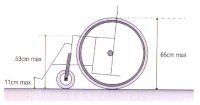
[Purpose] A potential issue for wheelchair sports are the characteristics of wheelchair design. The purpose of this review was to investigate the characteristics of design in wheelchair sports including the height of seat, camber and handrim size for improving the performance. [Results] The optimum height of seat related to trunk, arm length and handrim size. The lower seat showed the push efficient highly, while higher seat increased the energy expenditure. In energy expenditure, the optimum height of seat was 100-120° of elbow angle. Handrim size play the role in gear. The smaller handrim size acts like high gear, it gains disadvantages in acceleration, it gains advantages in maximum velocity. On the contrary, the higher handrim size acts like low gear, it gains disadvantages in maximum speed, it gains advantages in acceleration. The ratio of gear consideration in power and velocity. When increased camber enhanced the lateral stability, easier catch the handrim and easier arm motion. So it improved the energy expenditure and push technique. When increased camber enhanced the mechanical efficiency and stability, but it decreased the power. The racing wheelchair camber using the 8° and 10°. [Conclusion] Athletes, coaches and wheelchair experts are provided with insight in the performance effect of key wheelchair design settings, and they are offered a proven sensitive method to apply in sports practice, in their search for the best wheelchair-athlete combination.

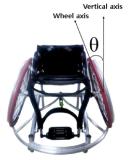
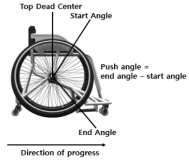
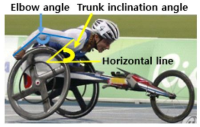

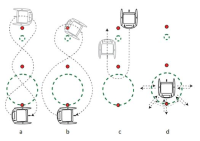
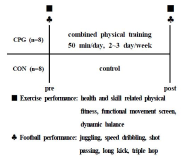
[Purpose] This study aimed to examine the effects of complex physical training on exercise and football performances in youth football players. [Methods] The subjects (n=16) were randomly assigned to either a complex physical training group (CPG, n=8) or a control group (CON, n=8). CPG was performed the complex physical training for 50 minute per day, and 2∼3 times per week, for 8 weeks. Exercise performance (health related physical fitness, skill related physical fitness, Y-balance and functional movement screen; FMS) and football performance (juggling, speed dribbling, shot passing, long kick and triple hop) were measured before and after 8 weeks complex physical training. [Results] Sit-up (p=0.002), sit and reach (p=0.040), 50-m run (p=0.031), side step (p=0.005), single-leg standing with eyes closed (p=0.040), plank (p=0.023), dominant composite score (p=0.002) and non-dominant composite score (p=0.005), deep squat (p=0.009), inline lunge (p=0.042), active straight leg-raise (p=0.015), rotary stability (p=0.049), total score(p=0.001), speed dribbling (p=0.030), dominant triple hop (p=0.001) and non-dominant triple hop (p=0.032) were statistical significant interactions between group and time. [Conclusion] Our findings indicate that complex physical training has beneficial effects on performance improvement of exercise and football in youth football players.


Purpose The purpose of this study was to examine the effects of 16 weeks’ combined exercise training on insulin resistance, inflammatory markers, oxidative stress, leukocyte telomere length, body composition, and daily living fitness in elderly women with type 2 diabetes mellitus (DM). Methods Twenty-eight participants were randomly assigned into one of two groups, i.e., exercise training group (EX: n=14) and control group (CON: n=14). Subjects in EX participated in 3 sessions of 60 min-combined exercise for 16 weeks, whereas subjects in CON were asked to maintain their normal life pattern during the same period. The variables regarding insulin resistance, inflammatory markers, oxidative stress, leukocyte telomere length, body composition, and daily living fitness were measured and compared between two groups as well as between pre-post test utilizing a repeated two-way ANOVA. Results Main results were as follows: 1) Fasting plasma insulin and HOMA-IR tended to decrease in EX, whereas increased significantly in CON. 2) IL-6, TNF-α, hs-CRP decreased in EX, but the changes were not statistically significant. 3) MDA increased significantly and GPx decreased significantly in both EX and CON. 4) Leukocyte telomere length increased significantly in EX. 5) Fat-free mass increased in EX, whereas fat mass and percent body fat decreased significantly in EX. 6) Arm curl, chair stand, sit & reach, tandem test, 10m walking speed, and up & go improved significantly in EX. Conclusion It was concluded that the combined exercise for 16 weeks had a positive effect on improving insulin resistance, increasing leukocyte telomere length, as well as enhancing body composition and daily living fitness in elderly women with type 2 diabetes.

Purpose The present study explored biological autonomy and control of function in circumstances that assessed a presumed relationship to an environmental cycle. An understanding of this behavior appeals to the organism-environment system rather than simply the organism—we seek to expose the laws that underlie end-directed capabilities by measuring biological characteristics (motor synchrony) in an environmental cycle (circadian temperature). Methods Participants (n = 24) at the University of Connecticut (Storrs, USA) and the Seoul National University (Seoul, Korea) served in the study. The production of in-phase bi-manual coordination was examined at different circadian points (allowing comparison of day-night temperature effects) in two experimental designs; (1) normal temperature embedded in a 24 hour cycle (5:00, 12:00, 17:00, and 24:00), and (2) normal versus abnormal temperature [artificially decreasing or increasing] while embedded at two points (5:00 am, 5:00 pm) during the circadian process. A typical bi-manual stability measure varied significantly as a function of the day-night temperature cycle. Results While (i) circadian effects under the artificially perturbed temperature manipulation were not straightforward along the day-night temperature cycle, (ii) the circadian effect divided by the ordinary circadian seems to be constant along the day-night temperature cycle. Conclusions The discovery of direct and robust relation between biological aspects (body temperature and motor synchrony) an environmental process (circadian temperature cycle) may echo adaptation of our biological system to the environment. This relation supports the claim that the organism and the environment should be considered as integrated system in which biological (or physical) dynamics takes place as a mutual factor.


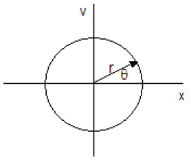

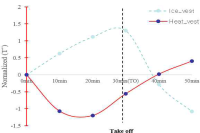

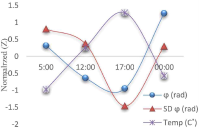

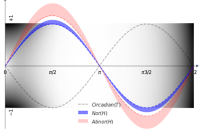
The purpose of this study was to investigate the effects of 8 weeks of aerobic training and resveratrol supplementation on a body composition, physical fitness, insulin resistance, liver function, blood pressure, and heart rate. Fifty-one elderly women were randomly assigned to aerobic training group (EX: n=12), resveratrol supplementation group (R: n=13), combined aerobic training and resveratrol supplementation group (EX+R: n=12), and control group (CON: n=14). The subjects in EX group exercised three sessions per week, 40 minutes per session for 8 weeks, the subjects in R group took 500 mg of resveratrol per day for 8 weeks, and the subjects in EX+R group received both treatments. The subjects in CON group were asked to maintain normal daily life pattern without any treatment for the same period of intervention. Body composition, physical fitness, insulin resistance, liver function, blood pressure, and heart rate were measured at pre- and post-test and the data were compared among groups and between tests by utilizing two-way ANOVA with repeated measures. Main results of the present study were as follows: 1) Physique and body composition did not change significantly in all groups. 2) Muscular endurance increased significantly in EX+R group, whereas the other physical fitness-related variables showed no significant changes in all groups. 3) Fasting glucose, fasting insulin, HOMA-IR, and HbA1c tended to be improved in EX+R group. 4) AST, ALT, and γ·GT showed no significant changes in all groups. 5) Systolic blood pressure and diastolic blood pressure increased significantly in CON group. Heart rate tended to be decreased in EX+R group and EX group. It was concluded that the 8 weeks of aerobic training and resveratrol supplementation had positive effects on muscular endurance, insulin resistance, and blood pressure in T2DM elderly women. Research investigating the effects of a longer period of aerobic training and resveratrol supplementation on the same variables would be warranted in the future.
PURPOSE This study aimed to explore the effective and pragmatic idea regarding the development of physical education teacher education (PETE) programs in China. These programs share both similarities and differences in China and Korea, and they are also discussed here. METHODS Six universities reflecting the regional specificities of Korea and China were selected following consultation with experts. Data collected through in-depth interviews, non-participatory observation, literature, and local documents were analyzed and interpreted by using the comparative analysis research method. RESULTS First, when comparing the curriculum, which was divided into liberal arts, major, and teaching subjects in both countries, the ratio of liberal arts and teaching subjects was similar in Korea following major subjects. As for China, major subjects came in first, followed by liberal arts and teaching subjects. Second, the relative pros and cons of preliminary sports teacher education in Korea and China were aimed at nurturing competent sports experts with both expertise and personality. They were generally similar in terms of content dimensions; however, they were found to be different in several areas. Particularly in the case of China regarding the teaching subject, practical subjects that were of pragmatic help to the school field were found to be relatively insufficient. Third, the implications for improving China's preliminary PETE were to emphasize the importance of personality in educational goals at the goal level, and as for the content level, it was necessary to replaced them with classes that could be of pragmatic use in the existing teaching method. Furthermore, at the methodological level, professional training of physical education teachers should be proposed, training them to cultivate character. Finally, more positive changes can be pursued if efforts at the environmental level are well-matched and improved. CONCLUSIONS To improve China's preliminary PETE program, it is necessary to enhance the environment and institutions using various teaching methods to cultivate expertise, such as practical aspects of university-field linkage and preliminary teacher personality education.